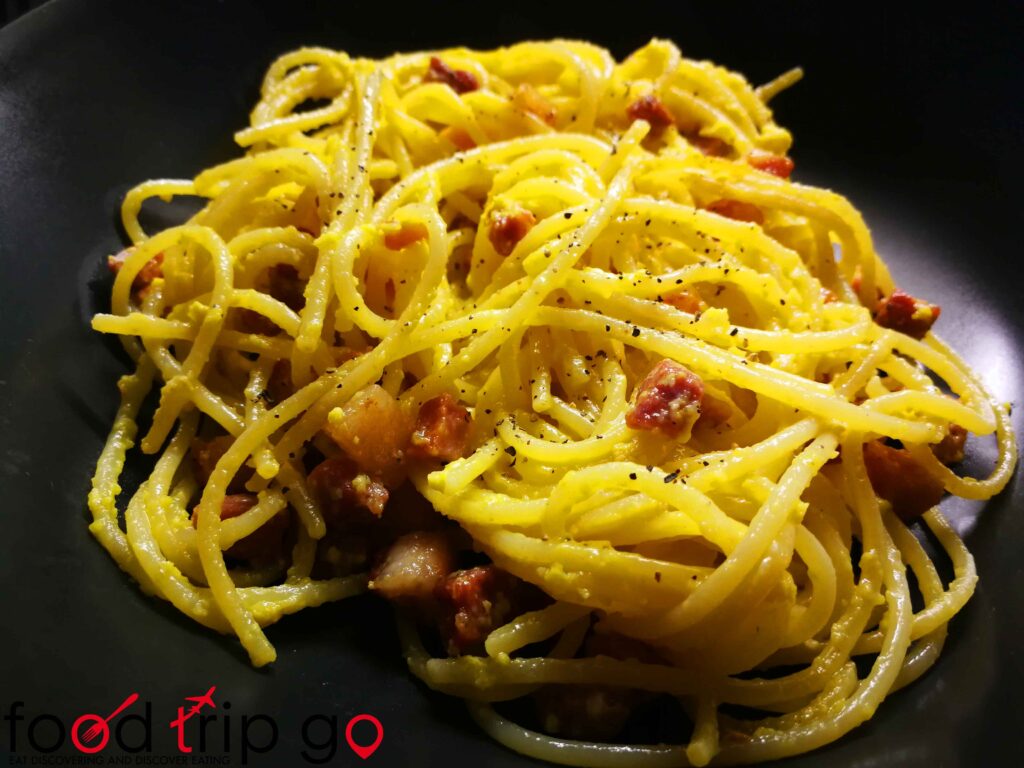The recipe to prepare one of the typical dishes of the Roman and Italian culinary tradition
The recipe for carbonara: so famous, so simple, and yet sometimes difficult to make perfectly obtaining an impeccable result. The fault is perhaps the countless versions, which risk confusing. Experience and chemistry applied to cooking come to our aid: traditional ingredients and some advice.
The recipe for spaghetti alla carbonara is said to have originated in Rome in 1944. The story goes that American soldiers, arrived in the Italian capital, had with them few products to feed themselves. They asked an imaginative Roman cook to create a tasty dish with what they had available. The result was the prototype of spaghetti alla carbonara: eggs, bacon (later guanciale) and cheese.

Spaghetti all Carbonara: traditional ingredients
- 250 g of guanciale
- 5 egg yolks
- 100 g of grated pecorino romano cheese
- Freshly ground black pepper
- The doses provided are sufficient to season 4 portions of spaghetti, 100 g per portion (400 g total of spaghetti)
Spaghetti alla carbonara: how to make the recipe, step by step
- Let’s put a pot with plenty of water and a little salt on the stove. For 400g of pasta you will need 4 liters of water and 2 teaspoons of salt (about 10g). The guanciale and pecorino used in carbonara are naturally sapid ingredients, so be careful not to salt the pasta water too much.
- While we wait for the water to boil, prepare the ingredients for the sauce.
- Remove the rind from the guanciale and, after scraping off the excess pepper, cut it into fairly thick strips.
- Break the eggs into a bowl.
- Add the pecorino cheese to the eggs (leave some aside to finish the dish before serving).
- Add a pinch of pepper to the mixture and stir vigorously with a fork or, even better, a small whisk.
- When the water has come to a boil, put the pasta on to boil. The cooking time will vary depending on the brand of pasta and the thickness of the spaghetti. Follow the indications on the package and plan to drain the spaghetti a minute before the total indicated time, in order to complete the cooking with the creaming in the pan.
- While the pasta is boiling, brown the guanciale in a large skillet (preferably non-stick) over medium heat. It will not be necessary to add any fat, the strips of guanciale will become crispy in their own fat.
- When the guanciale is browned and the pasta is almost cooked, add a couple of spoons of the pasta cooking water to the egg and cheese mixture and stir vigorously with a whisk. This step will help even the most inexperienced pasta maker to achieve a creamy carbonara.
- Drain the pasta by pulling the spaghetti out of the water with tongs or a large fork and placing them directly in the pan with the guanciale. This will help ensure that the pasta retains the right amount of cooking water needed to cream the spaghetti.
- Quickly toss the spaghetti for a few seconds, so that all the pasta comes into contact with the fat of the guanciale, and remove the pan from the heat.
- After removing the pan from the heat and making sure the fat has stopped sizzling, pour the contents of the bowl (eggs, cheese, pepper, cooking water) into the pan with the spaghetti and stir vigorously. You will see the cheeses melt completely and the sauce congeal but not coagulate.
- At this stage, to remedy any small errors in the execution of the recipe and still get a perfect carbonara, we suggest two little tricks.
- The first solves the problem of eggs that do not thicken: in this case, try putting the pan on the pot of boiling water, the heat will help the eggs to thicken a little more.
- The second is the only possible solution if you see that the eggs tend to curdle, turning your carbonara into a sort of pasta omelette. This often happens with thick-bottomed pans, which retain a lot of heat: quickly add another spoon of cooking water to the pan and continue stirring.
- At this point, the spaghetti alla carbonara is ready to be plated and served. Divide them among four bowls, sprinkle with the grated pecorino cheese you set aside and sprinkle generously with freshly ground black pepper.